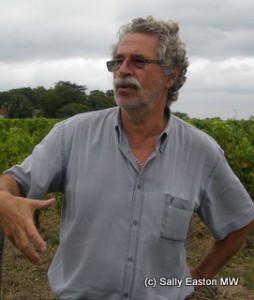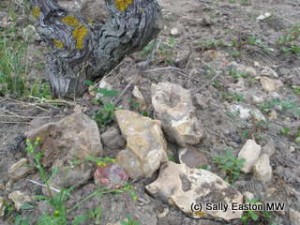Domaine de la Taille aux Loups

Jacky Blot
Owner Jacky Blot is one of those charming, unassuming iconoclasts of wine whose passion oozes from more pores than he possesses. Almost everything he says makes seductive sense even if you don’t actually quite understand it, and one could easily lose days of fascinating conversation and thesis in his company.
Blot has amassed some 60 hectares (ha) of vineyards in the Loire valley in two estates – 14ha of Domaine de la Butte in Bourgeuil, plus Domaine de la Taille aux Loups, covering the Vouvray and Montlouis appellations.
Just last year he bought the Le Clos de Mosny property in Montouis, with a full 12 hectares inside the walls, and another eight outside, including 1.6km of traditional wall. The 2011 vintage is his first from this Clos, which will eventually come under the wing of the Taille aux Loups domaine. Given that the entire Montlouis appellation is 380ha, his is no mean holding for one inspired individual.
Three quarters of his production is white, from the Loire’s chenin blanc, a grape variety Blot said “which corresponds strictly to the Loire” and on which he does his own massale selection using the many very old vines he has as indicators of the variety in its Loire terroir.
He’s investing €5,000 / hectare in his new vineyard, including planting new vines in the slightly down-at-heel Clos. The plans are to raise the canopy and lower fruit, so that “at the end of the day you get residual heat reflected up” to the ripening bunches. By taking leaves off the bottom of the canopy and lowering the fruiting canes, you need to go higher with the leaves, without getting too much leaf, Blot explained. And with all this effort, and by pruning in winter for the correct number of future bunches, Blot avoids the need to green harvest. Instead he gets a limited number of aerated bunches. And still he harvests only at around 30hl/ha, in comparison to appellation allowances of 52hl/ha.
Blot is a man passionate about geology too, saying “there is no appellation without geology”, adding that particular geology zones of the late/upper Cretaceous sedimentation are well suited to growing both Montlouis and Vouvray.
The Montlouis appellation fits snugly into the crook of land created where the river Cher flows in north-westerly direction into the river Loire. The land is only around 80m above sea level, with the river Loire still having around 200km to meander to the Atlantic Ocean.
Montlouis cross-section

Montlouis cross-section
Source: www.vinsdeloire.fr/SiteGP/FR/Appellation/Appellation/Montlouis-sur-Loire
The tuffeau, or tufa, (porous calcium carbonate-rich rock – limestone – laid down here under an ancient lake) so typical of this part of the Loire was laid down in the Turonian age of the Upper Cretaceous some 94 to 88 million years ago. It is into this tufa that caves were dug to excavate the rock for building in the Middle Ages, and that now form many a grower’s winery/cellar.
Overlaying this is younger yellow chalk of the Upper Cretaceous which contains lots of shells. And above this lies layers of sand, clay and flint in a free draining matrix. The silex/flint and sand “is a particular expression” Blot said.
Though Blot is not certified, he said “you can express terroir only if you farm organically. If you use chemical fertilisers, you may as well be growing tomatoes.” He hinted at his long term view when he said “my vision of wine doesn’t fit into the here and now.” And yet he’s a relative newcomer to winegrowing, having been a courtier/broker in the Loire and Burgundy some 20 years ago.
In his pursuit of the freshness, richness and purity that he says define Loire valley wines, Blot is pretty non-interventionist in approach, after the nine sorting tables have allowed him to select the fruit he’s happy to ferment. He said “after the grape there’s no intervention in the cellar, [though] we can increase the temperature a little to help fermentation.” Given the ambient 11 to 13°C of the underground cellar, fermentation is slow, even very slow, taking 4-5 months, and often up to nine months.

Flint in Clos du Mosny
Slow settling of juice, use of natural yeasts, fermentation in a cold cellar, fermentation in small volumes – barrels – which usually gives rise to fewer issues. And Blot added “without fertiliser in the vineyard parcels there is very little yeast-assimilable nitrogen [nutrients], in fact there’s so little nitrogen that some chemistry labs have said it’s impossible to ferment. But it does.” He added that once the first yeast populations have started fermentation, the second yeast populations feed on the nitrogen created by the first set of yeasts.
Blot is aiming for “very dry wines, with very, very augmented minerality.” But, he added “if minerality is on its own, this makes the wine hard to drink. The slowness of fermentation gives fatness and roundness to the wine, and the long fermentation is like a permanent battonage.”
All his wines ferment in barrel, with just 10% new, coming from an artisanal barrel maker in Burgundy.
His wines do not undergo malolactic fermentation. He said “I think a great grape can make great wines without residual sugar or malolactic. Malic acid gives an accent, and tones in the wine – a bit of relief or contour, and makes the wine agreeable.” He added the malic acid “is the spinal column of the wine, giving structure, adding relief and vibrancy to the wine [whereas] weight and body, roundness and flesh are coming from old vines, restricted yields, ripe grapes and the long fermentation.” He also said the low temperature of the cellar and the very slow fermentation protects the wine against malolactic fermentation occurring, which is important for him, as Blot doesn’t add sulphites in the cellar (which would help to block the malolactic).
Tasting notes, in situ, August 2011
Domaine de la Taille aux Loups, Triple Zero, Montlouis Sur Loire, Petillant naturel, €12
Traditional method sparkling, with a twist: it has zero chaptalisation, zero triage sugars, and zero dosage. To achieve this, fully ripe grapes are used, to provide all the requisite sugars. After about a nine month fermentation, the wine is bottled, still with around 12g/l sugars, for around 18 months. At disgorgement it is topped with wine, but no dosage.
It has a fine-looking mousse, both aesthetically and in terms of size of bubble. The nose is ripe with chenin blanc citrus and apple, the palate rich with almost tropical fruit, and the whole is pure.
Domaine de la Taille aux Loups, Les Dix Arpents 2010, Montlouis Sur Loire Sec €10
The “simplest wine in the house” and delicious at that. A ‘first tri’ or harvest selection wine, with fresh attack of spiced apples and pears, rich and enveloping, racy with juices. It has lovely intensity and balance.
Domaine de la Taille aux Loups, Remus 2009 Montlouis Sur Loire Sec €12
A ‘second tri’ wine, a blending of parcels closer to the Loire river, on clay soils.
Slight piquancy of citrus toast, lush and sweet fruited on the palate with broad white fruits – chin-dripping melon, apples, poached pears. Sweet texture and mouth enveloping fruit. Vg.
Domaine de la Taille aux Loups, Clos Michet 2009, Montlouis Sur Loire Sec €14
Also a ‘second tri’ wine. Floral nose, rich and enticing, hints of lemon curd, dry toast amid quince and almost tropicl fruits in a racy frame. Full breadth of palate in seamless quality. Vg.
Domaine de la Taille aux Loups, Remus Plus 2009, Montlouis Sur Loire Sec €16
From one part of the vineyards where vines are nearly 100 years old.
Quince, poached apples, piquancy of acidity offering height and backbone as counterpoint to sweet fat fruit. Life and vibrancy exude along this wine’s huge length.
Domaine de la Taille aux Loups, Clos de la Bretonniere 2009, Vouvray Sec €12
Bretonniere in Vouvray is calcareous with heavy clay that sticks to the shoes.
Blot: “2009 was quite problematic, I didn’t really like it at the beginning.”
Hint tarry and toasty on the nose, then fat and rich, with spiky, sweet leesy notes.
Domaine de la Taille aux Loups, Clos de Venise 2009, Vouvray Moelleux €20
Clos de Venise in Vouvray is silex/flint.
I would say almost fully sweet. Lush, fat, and fresh, with sweet melon. A dense, huge wine.
Domaine de la Taille aux Loups, Clos de Venise 2005, Vouvray Liquoreux €30
Richly honeyed, with more than 100g/l RS. Tropical, piquant notes and no sign of any ageing. The balance and depth of the whole thing is wonderful and remarkable.
Domaine de la Taille aux Loups, Romulus 2005, Montlouis Sur Loire Liquoreux €50
This wine is only make it when it’s very sunny, which results in the “great, late harvests being early.” 170g/l RS.
Tropical and spicy with huge depth and succulence. Lush in the literal and the colloquial. ‘nuff said.
My research visit to the Loire in August 2011 was sponsored by InterLoire.



